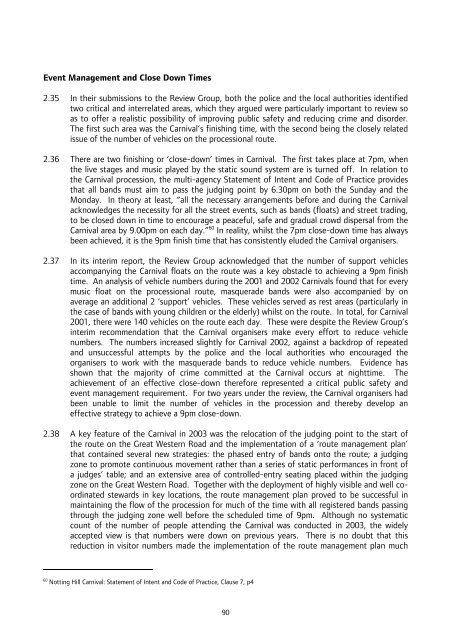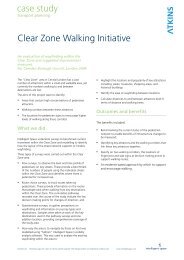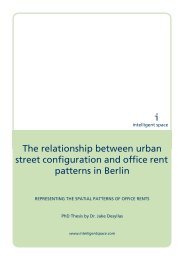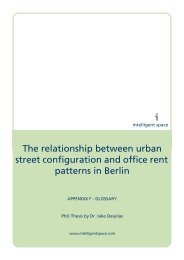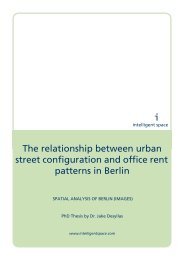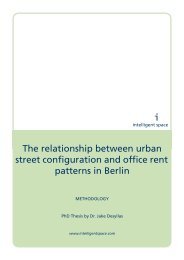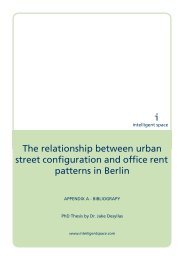Notting Hill Carnival Strategic Review - Intelligent Space
Notting Hill Carnival Strategic Review - Intelligent Space
Notting Hill Carnival Strategic Review - Intelligent Space
Create successful ePaper yourself
Turn your PDF publications into a flip-book with our unique Google optimized e-Paper software.
Event Management and Close Down Times<br />
2.35 In their submissions to the <strong>Review</strong> Group, both the police and the local authorities identified<br />
two critical and interrelated areas, which they argued were particularly important to review so<br />
as to offer a realistic possibility of improving public safety and reducing crime and disorder.<br />
The first such area was the <strong>Carnival</strong>’s finishing time, with the second being the closely related<br />
issue of the number of vehicles on the processional route.<br />
2.36 There are two finishing or ‘close-down’ times in <strong>Carnival</strong>. The first takes place at 7pm, when<br />
the live stages and music played by the static sound system are is turned off. In relation to<br />
the <strong>Carnival</strong> procession, the multi-agency Statement of Intent and Code of Practice provides<br />
that all bands must aim to pass the judging point by 6.30pm on both the Sunday and the<br />
Monday. In theory at least, “all the necessary arrangements before and during the <strong>Carnival</strong><br />
acknowledges the necessity for all the street events, such as bands (floats) and street trading,<br />
to be closed down in time to encourage a peaceful, safe and gradual crowd dispersal from the<br />
<strong>Carnival</strong> area by 9.00pm on each day.” 60 In reality, whilst the 7pm close-down time has always<br />
been achieved, it is the 9pm finish time that has consistently eluded the <strong>Carnival</strong> organisers.<br />
2.37 In its interim report, the <strong>Review</strong> Group acknowledged that the number of support vehicles<br />
accompanying the <strong>Carnival</strong> floats on the route was a key obstacle to achieving a 9pm finish<br />
time. An analysis of vehicle numbers during the 2001 and 2002 <strong>Carnival</strong>s found that for every<br />
music float on the processional route, masquerade bands were also accompanied by on<br />
average an additional 2 ‘support’ vehicles. These vehicles served as rest areas (particularly in<br />
the case of bands with young children or the elderly) whilst on the route. In total, for <strong>Carnival</strong><br />
2001, there were 140 vehicles on the route each day. These were despite the <strong>Review</strong> Group’s<br />
interim recommendation that the <strong>Carnival</strong> organisers make every effort to reduce vehicle<br />
numbers. The numbers increased slightly for <strong>Carnival</strong> 2002, against a backdrop of repeated<br />
and unsuccessful attempts by the police and the local authorities who encouraged the<br />
organisers to work with the masquerade bands to reduce vehicle numbers. Evidence has<br />
shown that the majority of crime committed at the <strong>Carnival</strong> occurs at nighttime. The<br />
achievement of an effective close-down therefore represented a critical public safety and<br />
event management requirement. For two years under the review, the <strong>Carnival</strong> organisers had<br />
been unable to limit the number of vehicles in the procession and thereby develop an<br />
effective strategy to achieve a 9pm close-down.<br />
2.38 A key feature of the <strong>Carnival</strong> in 2003 was the relocation of the judging point to the start of<br />
the route on the Great Western Road and the implementation of a ‘route management plan’<br />
that contained several new strategies: the phased entry of bands onto the route; a judging<br />
zone to promote continuous movement rather than a series of static performances in front of<br />
a judges’ table; and an extensive area of controlled-entry seating placed within the judging<br />
zone on the Great Western Road. Together with the deployment of highly visible and well coordinated<br />
stewards in key locations, the route management plan proved to be successful in<br />
maintaining the flow of the procession for much of the time with all registered bands passing<br />
through the judging zone well before the scheduled time of 9pm. Although no systematic<br />
count of the number of people attending the <strong>Carnival</strong> was conducted in 2003, the widely<br />
accepted view is that numbers were down on previous years. There is no doubt that this<br />
reduction in visitor numbers made the implementation of the route management plan much<br />
60<br />
<strong>Notting</strong> <strong>Hill</strong> <strong>Carnival</strong>: Statement of Intent and Code of Practice, Clause 7, p4<br />
90


